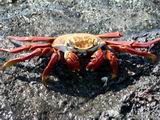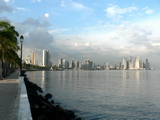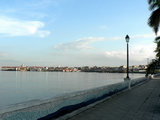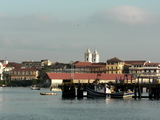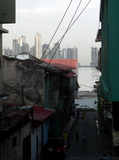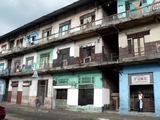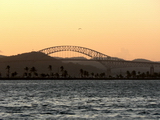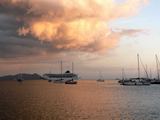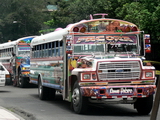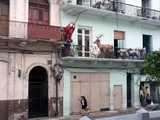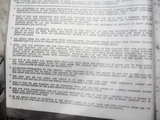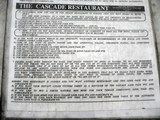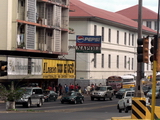 Lietuviskas aprasymas zemiau
Lietuviskas aprasymas zemiau
Wanna see all reports? Click here
Days 76-80: Mind the Gap
April 24-28, 2006
Even those who have already seen most of Central America are likely to find Ciudad de Panama visually astonishing. Located right in the middle of the New World, at the confluence of two oceans and two continents, the capital of Panama is a city of many contrasts: the new and modern El Cangrejo, somewhat reminiscent of Downtown Chicago, is situated at the left end of Bahia de Panama, while the very different colonial Casco Antiguo, often compared to Old Havana, is located on the opposite side of the bay, just a few kilometers away. When standing at the center point of Bahia de Panama, an unusual vision can be observed: on the left, there is Chicago, Havana is on the right, and the geographical center of present Panama City stays right behind you!
In fact, Panama City has two historic districts: on the opposite side of Bahia de Panama, east of El Cangrejo, there are stone ruins of Panama Viejo. The first Panama City was founded by the Spanish at the beginning of the 16th century. The settlement was completely destroyed by the English pirate Henry Morgan a century and a half later, and was later reestablished in the area on the other side of the bay.
Adding to the diversity of the place, Baha'i and Hindu temples peacefully stand along with the colonial Catholic churches; old-fashioned Soviet style diners mingle with fancy modern restaurants; antique Russian Ladas share the streets with Japanese cars and American chicken buses; there is a national park (Parque Natural Metropolitano) full of monkeys, sloths, deer, iguanas, turtles and tortoises right in the middle of the city; and one of the best accessible tropical rain forests of the country (Parque Nacional Soberania) is only about 20 miles away. In the center of the city, a tidy street full of expensive hotels and restaurants appears right next to a filthy one packed with shabby houses, bags of stinking food leftovers, and even dead rat bodies!
Finally, there is also the Canal, and, of course, the Gap.
When speaking about the Gap, we do not mean the legendary water gap between
the continents, known as the Panama Canal. There is a long and beautiful Puente
de las Americas (the Bridge of the Americas) proving a passage over the world-famous
waterway. However, about 170 mi/ 275 km south of Panama City, at the little
jungle town of Yaviza, the Pan-American Highway abruptly terminates and gives
way to lianas and swamps, inhabited largely by jaguars, crocodiles, narco-traffickers,
guerrillas, bandits and Colombian paramilitary forces. At Yaviza, it is literally
the end of the road. There are no gravel roads, dirt roads, minor roads or
marked tracks. In fact, there is no way whatsoever for a vehicle to pass through
the Darien jungle and cross the Colombian border by land.
The transportation break between Panama and Colombia continues for 54 mi/ 88 km and is known as the Darien Gap. It is the only break in the entire 16,000 mi/ 25,800 km-long Pan-American Highway. Initially, the Darien Gap was not paved because of the technical difficulties caused by the extremely challenging environment of the jungle, whereas nowadays it has turned into a concern of the Panamians that a road could help Colombia's civil war spill over into Panama, as well as increase illegal immigration and drug traffic. One way or another, it is very unlikely that a road through the Darien Gap will be built any time soon.
Past the Darien Gap, there is Colombia. Our initial itinerary included driving across Colombia, however, the more people we talked to, the more obvious it became that we should perhaps reconsider our decision to bring a car with a Californian license plate into a country where most of the roads outside major cities are controlled either by FARC or by ordinary bandits. Well, if the people who currently live there advise us to send all our good-bye letters before getting on the road in Colombia, then we will probably visit this country at some other time :)
This way the gap to mind becomes even wider, as now we have to find a way from Panama straight to Ecuador. Luckily, Panama City is a huge port, and there are cargo ships sailing from here to probably anywhere in the world. Less fortunately, the cargo that the ports of Panama handle is of enormous proportions (hundreds or thousands of containers per order), and a lone traveler with a little car is most often looked at as somebody trying to buy one bolt in a steel factory.
Since we arrived in Panama City knowing practically nothing about the possible
ways to transport a vehicle (all we had read beforehand was that there were
no car ferries, therefore the car would have to be transported in a container),
our first four days in the capital turned into a full-time study of maritime
shipping companies: get up in the morning, borrow the Yellow Pages from the
hotel, buy the latest newspaper, head to the Internet café across the
street and spend the rest of the day calling and e-mailing potential carriers.
At the beginning it all seemed like a total waste of time. Most of the phone
numbers recommended by prior travelers were no longer in use. The well-known
shipping giants, like Maersk, Barwill and DHL, were either very slow to respond
or immediately refused to deal with individuals. Some of the companies we
managed to reach were no longer sailing to Ecuador, while some others could
only offer containers with built-in refrigerators (not sure if our Nissan
would appreciate that :)) And finally, some sales people would take our e-mail
address and promise to send us a quote "as soon as possible" (better
than an instant "no", but we know just too well what "a.s.a.p"
often means!!). After two unproductive days on the phone we even double-checked
the map of Panama - just in case we overlooked some tiny path across the Darien
Gap :)
At the end of the fourth day of research there finally was a light at the end of the tunnel. We had received several reasonable offers, most of them from consolidators (the shippers that collect smaller parcels from different customers). Most of them gladly agreed to stuff our car into their containers alongside with an impressive assortment of other things. Since the memories of Captain Berto, the king of all consolidators, were still painfully fresh, we decided to do everything it took to protect the Nissan from being consolidated again :)
Luckily, some of the well-known and reputable carriers also responded positively, and the prices they quoted were more or less what we expected to pay ($750 to $1700, depending on the number of "extras": some shippers take care of all the customs formalities, while others just lend you a container leaving you on your own with all the car export/ import issues and loading/ unloading formalities).
However, by that time our brains had already received an overdose of the shipping stuff and refused to make any decision without a break. So we took a day off and went to see the Canal.
Local quirks: Some neighborhoods in Panama are cleaned using a very peculiar technique. Instead of simply removing the trash from the streets, they have a cute white truck that carries a tank filled with some sort of badly stinking chemicals. Every evening the truck circles around the neighborhood spraying the stuff from the tank on everything and everyone on its way. Blame yourself, if you happen to be in the area at the time the truck is at work! We got hit twice, and the second time - swear to God! - the truck was chasing us in order to spray us again!!!
Click on the pictures to enlarge
|
El Cangrejo is on the left side of the bay I kaire nuo ilankos - El Cangrejo |
Casco Antiguo is on the right I desine - Casco Antiguo |
A closer look at the historic district Istorinis Panamos rajonas is arciau... |
|
Inside Casco Antiguo ....ir is labai arti |
A different street Kitokia gatve |
Puente de las Americas (The Bridge of the Americas) Amerikas jungiantis tiltas - ilgas ir grazus Puente de las Americas |
|
A serene evening at the Pacific Ramus vakaras prie Ramiojo vandenyno |
Rey de la carretera :) Keliu karalius :) |
IQ test question. Which of the objects in the balcony: the deer, the giant parrot, or the head of an angel does not belong to the group? IK testo klausimas. Kuris is balkone esanciu objektu - stirna, milziniskoji papuga ar angelo galva - nepriklauso siai grupei? |
|
La Cascada restaurant in Panama City is worth a visit even if you are not hungry! Linksmasis restorano "La Cascada" meniu. Cituojame 5-ji punkta: "Pastaba: (Visi musu patiekalai yra tik vienam zmogui). Yra Kaskados pasidiziavimas kad vietoj leksciu ji naudoja bliudus ir visos porcijos kurias ji patiekia yra gausios ir ypac super porcijos ir super kombinacijos yra milziniskas dydis zmonems turintiems gera didiji apetita bet prasome visados uzsisakyti pagal asmenini apetita todel kad neleidziami dalintis maisto o jei kas nors atkakliai reikalauja dalintis su kitu suaugusiu asmeniu kainuos 0.75 cento daugiau uz papildoma lekste irankius ir serveteles". |
Where else in the world will you get a 50-page menu which is so confusing that it is nearly impossible to follow, but is guaranteed to keep you laughing for hours?!! Ir panasiai - dar 49 puslapiai! :) |
To our Napoli friends - from Panama, with love! :) Speciali nuotrauka musu draugams napolieciams - sivakar puse devyniu Napoly?? :) |
Nuvesk pelyte virs paveiksliuko, spustelk jos kaire ausele, ir paveiksliukas padides
76- 80-oji dienos: Tarp Cikagos ir Havanos
2006 m. balandzio 24-28
Visa nakti po El Valle siaute audra. Stiprus vejas lauze medziu sakas ir garsiai varte kazkokius viesbucio kieme paliktus sunkiasvorius rakandus. Prilijo tiek, lyg dangus musu atvaziavimo proga butu sliukstelejes poros metu vandens atsargas. Pries ryta vejas aprimo, oras isilo, taciau siltas tropinis lietus tebelijo net ir tada, kai apie vidurdieni privaziavom Ciudad de Panama - Panamos sostine. Ar tik Centrineje Amerikoje nebus prasidejes mums visai nepalankus ir nepageidaujamas lietaus sezonas?
"Isstudijave" jau nemazai Centrines Amerikos miestu, is Panamos sostines daug nebesitikim - greiciausiai, bus panasi i bet kuri kita didmiesti, ir tiek. Taciau labai kontrastingas metropolis netiketai nustebina. Visu pirma - vizualiai. Tereikia nueiti i Bahia de Panama ilankos pakrante (Panamos miestas istises apie 20 km i ilgi palei Ramuji vandenyna, ir visos gatves is centro leidziasi tiesiai link ilankos), atsisukti veidu i vandeni ir apsidairyti. Staiga desineje pasirodo Havana, kaireje - Cikaga, o uz nugaros lieka Panama! (Karstis ir nuovargis cia nei prie ko! - miestas taip idomiai padalintas, kad siek tiek i senaja Havana panasus Casco Antiguo rajonas lieka viename ilankos gale, kazkiek Cikagos dangoraizius primenanti komercine miesto dalis - El Cangrejo - kitame, o likusi Panama driekiasi i siaure nuo ilankos).
Casco Antiguo ir El Cangrejo dramatiskai skiriasi ne vien is tolo. Senajame
kolonijiniame Casco bet kuris namas skaiciuoja jau keliolikta desimtmeti.
Deja, dauguma istoriniu pastatu smarkiai prasosi bent siokio tokio aptvarkymo,
spalvos atnaujinimo ar atsilaupiusiu sonu aplopymo. Restauracija vyksta, taciau
taip pamazu, kad kol kas Casco atrodo liudnokai: vienas namas - dazniausiai
kokia valstybine istaiga - atrestauruotas ir isgrazintas, visas tviska, rodos,
net kvepia svieziais dazais... o i jo sona remiasi apsepusi lusna. Uzsuki
uz graziojo namo kampo, o ten - istisa apleistu, vaiduokliskos isvaizdos ir
paskirties rezidenciju gatve. Net baisu pagalvoti, kad juose kazkas nugyvena,
ko gero, visa gyvenima.
O kitoje ilankos puseje esanciame El Cangrejo nieko panasaus nepamatysi. Ten
viskas modernu, svaru, nauja, prabangu. Ispudis toks, lyg butumem staiga papuole
i kurio nors Valstiju didmiescio "downtown'a", tik Panamos gatvese
zymiai daugiau chaoso, kuri sukuria eismo taisykles ignoruojantys autobusu
ir taksi vairuotojai.
Miesto centre irgi netruksta nuostaba kelianciu vaizdu. Pavydziui, viena gatve - svari, tvarkinga, pilna prabangiu viesbuciu, restoranu ir parduotuviu; o gretimoje, esancioje vos uz 20 zingsniu - siaubinga netvarka ir nesvara, metosi apgrauzti vistu ir zuvu kaulai bei sauleje isdziuve ziurkiu lavonai. Per pirmasias dvi dienas atsirinkome, i kurias gatves daugiau nenorime kisti nosies :) Savotiskai idomus pasirode ir senoviniai, sovietinio tipo valgyklos-restoranai. Tokiu Panamos sostineje - apstu, kaip ir Lietuvoje jau egzotika tapusiu ziguliuku.
Del prasto higienos stovio sektoriu, miesto centro gatves periodiskai nupurskiamos kazkokiu bjauriai dvokanciu skysciu (tikriausiai, dezinfekuojanciu - gatvemis pravaziuoja didziule balta masina ir visus 5 metru spinduliu esancius objektus apslaksto labai nekvepianciu purskalu). Jeigu esi vietiniu tradiciju nezinantis miesto svecias ir netycia pasitaikai gatveje purskimo metu, baltoji masina be gailescio tave taip pat dezinfekuoja ir nuostabiai iskvepina. Mums taip atsitiko net du kartus! (Antra karta, pamate atvaziuojanti purkstuva, bandem begti, bet nespejom! Prisivijo ir vel nupurske :))
Vienas is malonesniu siurprizu - Panamos sostineje viskas salyginai pigu, netgi lyginant su kitomis Centrines Amerikos salimis. Pavyzdziui, labai padorus, tvarkingas viesbucio kambarys su kabeline TV - reta prabanga pigiuose viesbuciuose - kainuoja apie $12-15 parai. Labai apsidziaugem toki rade, nes kaip tik siomis dienomis Prahoje turejo prasideti Eurolygos finalas, i kuri truputi nespejom (nusipirkom bilietus dar pries kelione, kai galvojom, Centrine ir Pietu Amerikas pervaziuosim mazdaug per TRIS menesius :))) - didelis aciu TJui, pasirupinusiam laimingu bilietu likimu!).
Nebrangus pragyvenimas dar labiau suaktualejo tada, kai supratom, jog Panamoje teks prabuti gerokai ilgiau, negu pageidautumem - masinos perkelimo i Pietu Amerika per diena ar dvi suorganizuoti neiseis. Per kelias dienas paaiskejo, kad vargiai iseis net ir per savaite. Bet apie viska - is eiles. Trumpai priminsim, kad pervaziuoti is Centrines i Pietu Amerika yra neimanoma. Greitkelis Panamericana (Pan-American Highway), teoriskai jungiantis abu kontinentus, is tikruju tesiasi tik iki Kolumbijos pasienyje esancio Yavizos kaimo, ties kuriuo, tikraja prasme, yra kelio galas. Panamericana is naujo prasideda jau Kolumbijoje, uz 88km nuo Yavizos. Pelketa, tankiomis dziunglemis apzelusia atkarpa, vadinama Darien tarpu (Darien Gap), teoriskai imanoma perbristi pesciomis. Taciau labai retai atsiranda drasuolis, sugalvojantis savanoriskai pulti i glebi nuo teisesaugos besislepiantiems nusikalteliams, narkotiku prekeiviams, kontrabandininkams, partizanams ir laukiniams zverims - 88km dziugliu ruoze reziduoja pakankamai visu isvardintu rusiu atstovu. Darien tarpas labiausiai garseja tuo, kad isejusieji jo apziureti dazniausiai dingsta be zinios.
Norintiems dingima be zinios is keliones tvarkarascio eliminuoti, iseiti siulo juru transporto kompanijos. Transporto priemone keliauja i konteineri, konteineris - i didziuli laiva, o keleiviai - i lektuva. Is Panamos arba Colono (dvieju pagrindiniu Panamos uostamiesciu) masina galima siusti i Kolumbija, Venesuela arba Ekvadora. Tarp $800- $1700 svyruojanti kaina priklauso nuo konteinerio dydzio (20 pedu/6-7m ar 40 pedu/12-13m ilgio), kompanijos reputacijos, issiuntimo greicio (pats siuntimas trunka apie 4-7 dienas, bet gali tekti savaitele-kita palaukti eilej prie issiuntimo) bei papildomai siulomu paslaugu, kuriu gali arba visai nebuti (kompanija tik nuplukdo konteineri su masina), arba buti daug ir tikrai naudingu (kompanijos agentas sutvarko visus dokumentus ir muitines formalumus, todel klientui tereikia tik palikti masina Panamos uoste ir sutartu laiku atsiimti ja Pietu Amerikoje). Greitis ir patogumas, savaime aisku, nemazai kainuoja. Ypac brangiai atsieina pagalba tvarkyti dokumentus (kaip veliau supratome - ne be pateisinamos priezasties!).
Visa tai zinome dabar. O tik atvaziave i Panama apie tai, kokiais keliais musu masina plauks i pietus, dar nezinojome nieko (informacija internete/ kelioniu knygose - minimali, ir ta pati - pasenusi). Todel pirmosios keturios dienos sostineje prapuole kazkur tarp geltonuju puslapiu, telefono ir interneto - intensyviose juru transporto kompaniju studijose. Kad uzduotis netycia nepasirodytu per lengva, kartu su informacija apie laivus gavome dar ir gera doze pikantisku atsiliepimu apie Kolumbija, i kuria planavome siusti Nissana. Vos spejome demetis besikartojancius patarimus pries vaziuojant per Kolumbija su JAV numerius turincia masina (is kurios, anot TJaus, FARC - pries valdzia kovojanti ginkluota grupuote, neretai grobianti zmones - jau maziausiai tris kartus suzaide kortomis) atsisveikinti su artimaisiais ir butinai uzsiregistruoti Lietuvos konsulate, kad visi kada nors musu pasigesiantieji tolimesnieji galetu patenkinti smalsuma ir suzinoti, kur baigesi musu kelione.
Treciadienio vakare, kai jau buvom pasikalbeje su visais, norinciais ir galinciais padeti Nissanui pasiekti Lotynu Amerika, atejo laikas priimti kompetetinga sprendima. Nusprendeme praleisti Kolumbija, ir siusti Nissana tiesiai i Ekvadora. Taciau sitoj vietoj kompetencija baigesi - per keturias dienas prisirinkome tiek kainu ir kompaniju su ivairiausiais privalumais ir trukumais, kad nors imk ir trauk burtus! Negalejimo apsispresti proga paskyreme smegenims viena diena atostogu - galu gale, laikas pagaliau apziureti garsuji kanala!

